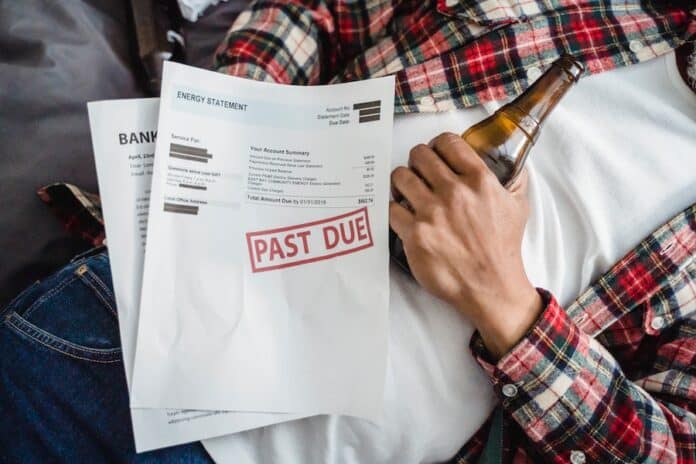Bankruptcy is almost a taboo subject. When you hear about it, you may slightly understand what happened to someone, but without knowing the full story, it’s hard to tell. Ultimately, when someone files for bankruptcy, it’s an indication that they don’t have the resources to pay their debt. While this is the case, bankruptcy is rarely that simple.
If you want to learn more about bankruptcy and how to view public records about bankruptcy, you’re in the right place. We’ll also take you through the bankruptcy process to give you a clear understanding of what it looks like when you file.
Read on to learn everything you need to know about bankruptcy, life after bankruptcy, and how to find your records.
What Is Bankruptcy?
Bankruptcy occurs when someone doesn’t have enough money to pay back their debts. It helps people start fresh by liquidating assets to help them cover their debts. Most debts are also settled in court for less than what the person owes. While this may help someone get out of a bad situation, it also leads to some complications. The biggest drawback of bankruptcy is that you’ll have little to no credit for 7-10 years. In fact, big purchases will be challenging to make for even longer.
There are also several types of bankruptcy that vary based on your circumstances. Some types of bankruptcy are for individuals, while others are for companies or government agencies.
How Long Does Bankruptcy Last?
Bankruptcy lasts for a period of 7 to 10 years on your credit report. Chapter 7 usually lasts for 10 years, while Chapter 11 and some other types of bankruptcy only last for 7 years. During this time, getting credit cards, loans, cars, or homes is challenging.
There are some things you can do to speed up the credit-rebuilding process. You can find a cosigner, have someone loan you money without going through a credit agency, or you can open a secure credit card.
Do You Have To Pay All Debts in a Bankruptcy?
Yes and no. In most cases, you have some types of debt exempt after filing for bankruptcy. For example, with Chapter 7 bankruptcy, your vehicle may be exempt, so you don’t have to sell it. On the other hand, some debts must be paid, and if you don’t have enough capital, things like your home can be sold to cover the debt.
Ultimately, it depends on the type of bankruptcy you file, where you live, and how much money you owe.
Is a Bankruptcy Public Record?
Yes, bankruptcy is a type of public record. It is done through the court system, so there is always a record of the proceedings. Bankruptcy records can be found at the courthouse or online through tools like Information.com. This makes them easily accessible for anyone that wants to view them.
Do You Need a Lawyer To File for Bankruptcy?
No, you don’t need a lawyer to file for bankruptcy. It’s possible to file by yourself, but we recommend against doing so. Filing without any plan or defense may put you in a bad position, which leaves you exposed to whoever you owe money to. Therefore, we recommend getting a lawyer to pay as little debt as possible. Without one, you may have to liquidate even more assets, so it’s usually worth the cost.
What Are the Types of Bankruptcy?
There are a few types of bankruptcy. They’re categorized into chapters, which outline the exempt debt, the type of person who can file for it, and more. In total, there are six bankruptcy chapters, and each chapter has its own rules and regulations.
- Chapter 7
- Chapter 9
- Chapter 11
- Chapter 12
- Chapter 13
- Chapter 15
When it comes to bankruptcy, the type is very important. For example, individuals can’t file for Chapter 12 bankruptcy if they don’t own a farm or any fishing equipment. Additionally, people can’t always file for Chapter 13 if they have more than $450,000 in unsecured debt.
Learn more about each type below.
Chapter 7
Chapter 7 bankruptcy is a type of liquidation bankruptcy and is one of the most common types filed for individuals and businesses. When you file, the court appoints a trustee, and they watch over your assets and the case as you liquidate them. It’s also important to note that you’re only able to file for Chapter 7 bankruptcy if the court determines that you don’t make enough money to pay the debts. Also, in cases of Chapter 7 bankruptcy, you will often meet with creditors who will ask questions about the debt to determine a settlement; unfortunately, these conversations can be uncomfortable.
Chapter 9
Bankruptcy that’s filed under Chapter 9 is a unique type of bankruptcy for government organizations. The government organizations that can file Chapter 9 include cities, towns, schools, and even counties. When an organization files Chapter 9, their debt is rearranged, and they’re put on a payment plan to begin paying it off, usually in monthly installments.
Chapter 11
Bankruptcy filed under Chapter 11 is useful for large companies and corporations. When a company doesn’t have enough cash to stay afloat, it can file for bankruptcy to rearrange the debt. In most cases of Chapter 11, companies continue to operate and repay the debt at the same time. Banks and creditors often agree on the best way this can be done.
Chapter 12
Chapter 12 bankruptcy is reserved for farmers and fishermen who own land, boats, equipment, and other items to run their operations. Essentially, it’s a payment plan that allows farmers and fishermen to pay their debts without losing the land or equipment. This is important because they wouldn’t be able to work or repay the debt without these items.
Chapter 13
Chapter 13 provides you with a payment plan that works best for you and the creditors. Unlike Chapter 7, your debt is not forgiven. Instead, you have to repay the debt in installments. Still, it may be less debt than what you started with. The impact on your credit score may also be less troublesome. Anyone can file for this type of bankruptcy, but there are a few rules. The big one is that the amount of unsecured debt is less than $419,275. However, you can file for Chapter 13 if you have up to $1.257 million in secured debt.
Chapter 15
Chapter 15 is one of the most unique types of bankruptcies. This is because it handles debt that isn’t domestic. Chapter 15 is for companies and individuals who have debt in other countries. You might have to work something out with their debt relief organizations, and because this type of bankruptcy can be complicated, we recommend hiring a lawyer.
What To Expect After Filing for Bankruptcy
Filing for bankruptcy may save you financially, but there are some things you must consider about what life is like after bankruptcy. Typically, these issues only last for a few years (up to 10), but they might change your mind about filing.
There may also be some unique situations depending on your debt and income, so use this as a general guide for what to expect.
It’s Hard To Get Credit
First and foremost, you’re going to struggle when you want credit. Getting credit is challenging enough without a bankruptcy on your record, but bankruptcy makes it even worse. It’s difficult to get credit because filing resets your credit score back to as low as it can be. Then, it takes years to reach poor, average, and good credit. If you think you’ll need credit in the near future, it’s not a good idea to file for bankruptcy.
That said, you can still get credit. However, you need some help from friends or family members. Someone will have to sign on the loan or credit card with you, or you’ll need to get a secured credit card to get started. Thankfully, you can start having average credit again if you pay all of your bills on time in about 5-7 years. Things like Experian Boost may also help.
You May Have To Sell Some Assets
Bankruptcy doesn’t always protect your assets. Depending on the type of bankruptcy you file for, you’ll have to sell some of your things. Some common assets that get sold to pay debts include things like cars, real estate holdings, investment portfolios, and sometimes even retirement accounts.
While a fresh start might be worth it, losing all of these things might not. Keep in mind that it will be harder to get a new home or car after the bankruptcy is filed.
Student Loans Don’t Go Away
Something that often gets overlooked is that student loans don’t go away when you file for bankruptcy. Depending on who holds the loan, it’s something you’ll still have to pay back. Therefore, it’s not always viable to use bankruptcy as a tool to remove student loan debt.
Still, having your other debts removed may free up the cash you need to pay for your student loans. Making payments on your loans over the next few years will also boost your credit and help you get back to where you were faster.
Depending on your unique situation, these are some of the things you can expect when filing for bankruptcy.
How To Recover From Bankruptcy
Bankruptcy makes it challenging to get credit, loans, and assets. Plus, you may still have some debts that didn’t get cleared during the bankruptcy, like a mortgage or student loans. The good news is that there are a few things you can do to recover from bankruptcy.
Maintain Your Home and Get a Job
Having housing and a job are the best ways to get back on your feet after you file for bankruptcy. The most important of the two is getting a job. With a job, you can pay for things, get secured credit cards, and maybe even get approved for an apartment. There are also some housing options for people with no credit, and we always recommend checking the guidelines laid out in the Fair Credit Reporting Act (FCRA) to know your rights when applying.
When you have a home and a job, it shows creditors that you can pay them back. Of course, it will take time to get back what you had, but it’s the best way to start.
Pay Your Bills on Time
This is one of the most obvious ways to improve your credit and recover after bankruptcy; always pay your bills on time. When your bills are paid on time, it will improve your credit score and show credit agencies that you’re trustworthy. This is especially true if you’re paying rent or a mortgage because these things may appear on your credit report.
If you want to get even more information on your credit report, you can try apps like Experian. They offer ways to boost your credit sooner rather than later.
Have Cash in the Bank
If you want to survive bankruptcy, you need some cash in the bank. Because getting a loan is harder, you’ll need to purchase things with cash. Without cash, you’ll struggle to get anything. Cash can even help with a down payment if you need a car or something else that’s expensive. Showing creditors that you can put up to 50% down goes a long way in showing them that you can pay back the debt. Having money in the bank also helps you get approved for things like a mortgage.
Get a Cosigner for Loans
Getting loans is almost impossible right after bankruptcy. That said, loans are an important part of having credit. Without loans, banks don’t know that you can pay back large sums of money with inconsistent payments. Therefore, it’s wise to get a loan or a credit card after bankruptcy when possible. Unfortunately, you’ll have trouble doing it alone.
This is where the cosigner comes into play. Having someone cosign on a car or loan will help you get approved, especially if they have good credit. Make sure you make all of your payments on time, and you can start to build your credit again.
Overall, these are some of the best ways to stay ahead of the game and recover from bankruptcy.
How To Check on Your Bankruptcy Status?
Knowing whether or not you have an active bankruptcy record on your public record report is essential. It determines if you can purchase property, take out a loan, and apply for credit cards. What’s more, it may prevent you from getting a car or an apartment.
The good news is that it’s not difficult to find this information when you know where to look. We’ll take you through the best methods below.
Public Records Search Tools
One of the best ways to find information about your bankruptcy status is to use a public records search tool. These are tools that allow you to find information about people, including yourself, by entering some simple information. Our favorite public records search tool is the one provided by Information.com.
We take you through the steps to use Information.com’s search tool below.
- Visit Information.com to use their public records search tool.
- Enter your first and last name, your address, and the state/city you live in.
- Select Search.
- Scroll through the results until you find your personal information.
- Open the Full Report.
Once you access the full report, you can view all records about yourself that are public records. This includes bankruptcy, criminal history, court records, pending lawsuits, and much more.
If nothing comes up about bankruptcy when you run the search, there’s a good chance you’re in the clear. That said, recent bankruptcies may take some time to show up in the database.
Can Bankruptcy Be Removed From Your Credit Report?
No, bankruptcy can’t be removed from your credit report. Bankruptcy can only be removed from your credit report after an allotted period, which is between 7 and 10 years. However, bankruptcies that you didn’t file or disputed bankruptcies can be removed from your credit report sooner. It’s a good idea to speak with an attorney in these situations.
Final Thoughts
Bankruptcy doesn’t have to be the end of the road for you financially. While it’s a good idea to file for bankruptcy in some unique situations, we recommend against it because you won’t have good credit for at least a decade. That said, if you have to file for bankruptcy, we recommend contacting a lawyer and going through your options.
It’s also important to note that there are sometimes mistakes in your credit report. If you notice a bankruptcy on your credit report that you didn’t file for, always be sure to dispute it. You can check your bankruptcy records with platforms like Information.com, Credit Karma, or Experian.












